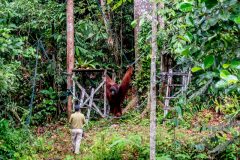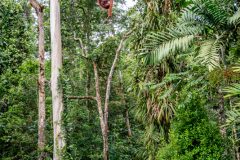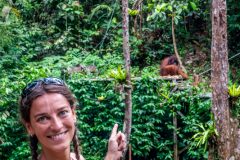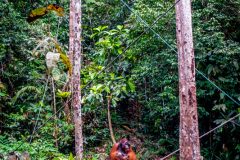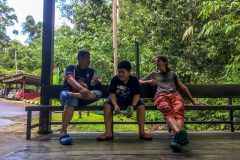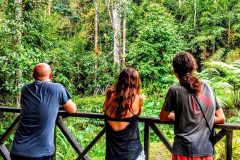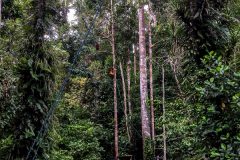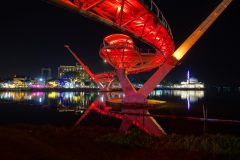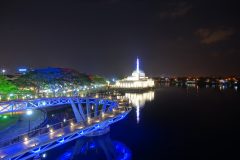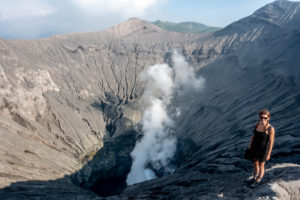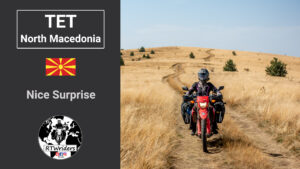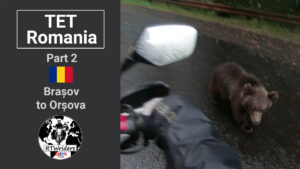When approaching Kuching, the capital of the state Sarawak in Malaysian Borneo, you can already notice out of the plane, how green Borneo is. Kuching is extremely relaxed and the hustle and bustle in West Malaysia hasn’t arrived yet.
The amount of tourists is very manageable. A large part of the population here are chinese immigrants, which fortunately benefited us a lot in that time, because it was Ramadan again. Under normal circumstances, eating during the day would have been extremely difficult, but the numerous chinese restaurants and the chinese people are not affected by that.
We shipped the bikes from malaysian mainland and they hadn’t arrived yet. So we had enough time to explore the area around Kuching until our motorbikes would arrive.
On the street we met Loris, a young swiss guy, who had also just arrived and we decided to explore Kuching together.
Borneo is one of the last places on earth, where you can see orangutans in the wilderness. Since they have become very rare, an easier place to meet them is Semenggoh Nature Reserve close to Kuching.
Ticket Prices 2020:
Foreigners: RM 10.00
Locals: RM 5.00
You can also find more informations on their website.
Even in green Borneo, the world is not as unspoiled as it seems. A large part of the jungle had to make room for palm oil plantations.
Although deforestation in Malaysia has been banned by now, it is gleefully continued on the indonesian side of Borneo. As a result, many wild animals have already lost their natural habitat. These include the critically endangered orangutans, which are only found in Borneo and Sumatra. The Wildlife Nature Reserve has specialised on these apes and tries to offer them an undisturbed habitat. Unfortunately the size of the forest area is way too small for the number of apes. For this reason, the animals have to be fed and these feedings can be attended by visitors twice a day.
First of all you might think of visiting a kind of a zoo. At the latest after the ranger’s introduction before feeding, you will realise that this is not the case. The feeding areas are on platforms in the woods, but there are no fences and barriers. Therefore orangutans can appear anytime and anywhere, but there is no guarantee that they can be seen at all.
We were lucky – one of the big males had come for lunch to one of the feeding places. We learned that these guys can be quite uncomfortable and the ranger’s instruction were told in no uncertain terms. “If he comes up towards us and I shout RUN, you should do that, because I will not wait for you! I’ve tried to help people who didn’t run before and I’ve ended up in hospital twice. So I won’t do that anymore. Run into an open area and not into the forest or a house, because that won’t stop him from catching you. First he will grap your arms with his hands, then he graps your legs with his feet and finally he will start biting your head. Keep your eyes open, we are now going through the forest to the feeding platform. Thanks for visiting and enjoy your time in the Semenggoh Nature Reserve.”
After this speech you could see in the visitor’s faces, that not only Miriam was a little puzzled – this is not a zoo! However – after a closer examination, she was left optimistic to notice, that most of the visitors are much more unsporty than her and that she can outrun them easily. So she confidently started following the ranger into the forest.
Luckily the huge male was not looking for stress that day and was sitting relaxed between a bunch of different fruits. So we had a great time watching this impressive animal for a while.
We enjoyed it so much, that we even came back a few days later with our friends Li Yee, a malaysian motorbiker, his son and our british biker friend Mike. This time there were two females with kids visiting the feeding area. We got explained, that we don’t need to watch out for the males now, because they wouldn’t come to the platforms with one of the males nearby.
However, a little bit later the females dissappeared and a massive male came towards the feeding area. We could see the trees moving from a distance. The other tourists had already left, so we could watch the ranger feed him quite close.
Conclusion: The Semenggoh Wildlife Reserve is not a typical southeast asian tourist attraction similar to a zoo, as we initially suspected. It is a really great and natural institution without souvenir shops and other tourist traps and really worth a visit. Finally our second visit was even better than the first one. So you need some luck in Semenggoh. Since it is not very far-off Kuching and the fees are cheap, it might be worth going there more than one time only.

